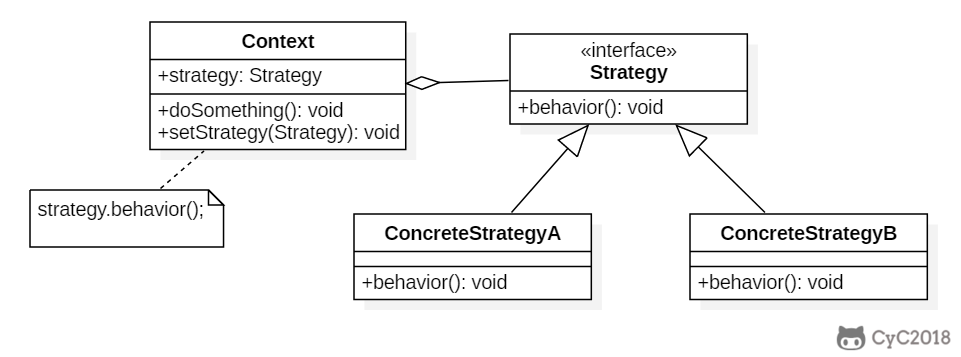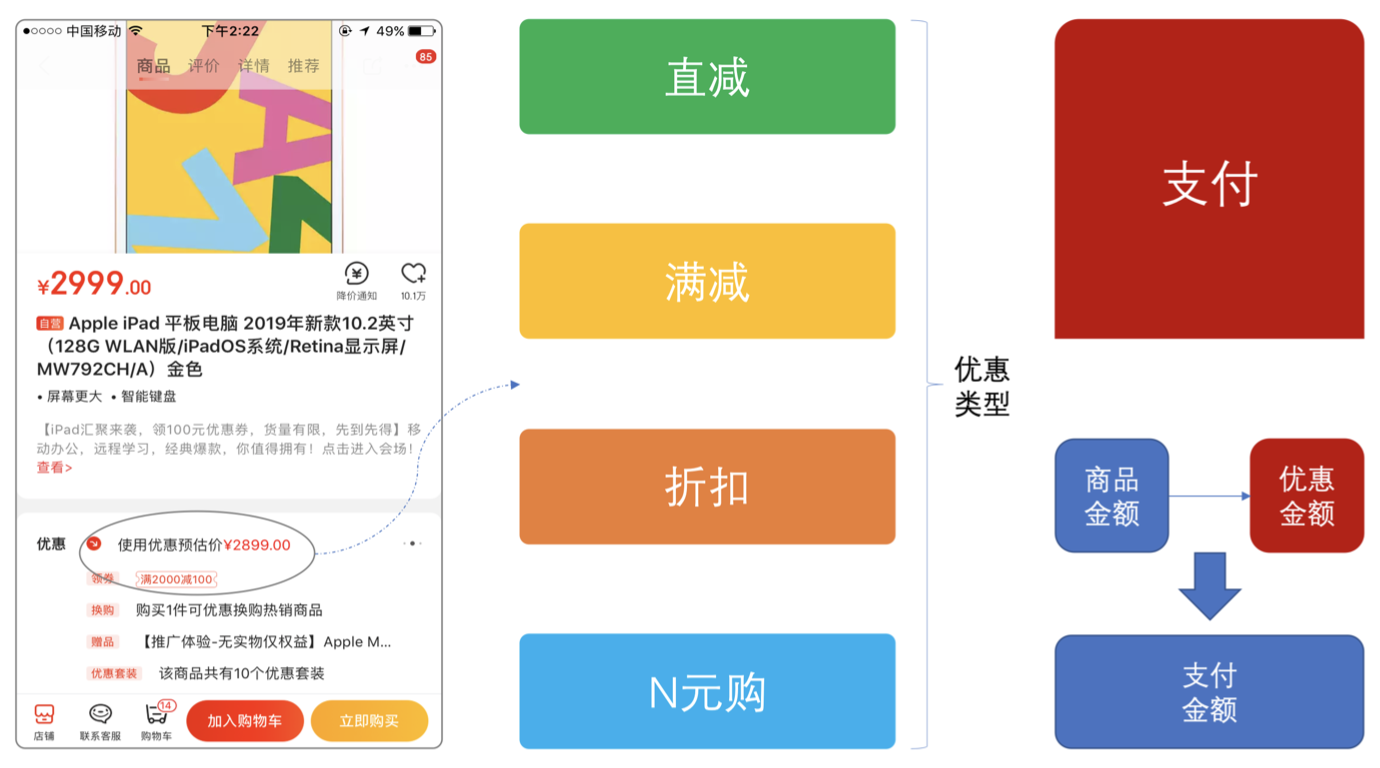
6-策略(常用)
策略(Strategy)
Intent

定义一系列算法,封装每个算法,并使它们可以互换。
策略模式可以让算法独立于使用它的客户端。
Class Diagram
Strategy 接口定义了一个算法族,它们都实现了 behavior() 方法。
Context 是使用到该算法族的类,其中的 doSomething() 方法会调用 behavior(),setStrategy(Strategy) 方法可以动态地改变 strategy 对象,也就是说能动态地改变 Context 所使用的算法。

与状态模式的比较
状态模式的类图和策略模式类似,并且都是能够动态改变对象的行为。但是状态模式是通过状态转移来改变 Context 所组合的 State 对象,而策略模式是通过 Context 本身的决策来改变组合的 Strategy 对象。所谓的状态转移,是指 Context 在运行过程中由于一些条件发生改变而使得 State 对象发生改变,注意必须要是在运行过程中。
状态模式主要是用来解决状态转移的问题,当状态发生转移了,那么 Context 对象就会改变它的行为;而策略模式主要是用来封装一组可以互相替代的算法族,并且可以根据需要动态地去替换 Context 使用的算法。
Implementation
设计一个鸭子,它可以动态地改变叫声。这里的算法族是鸭子的叫声行为。
public interface QuackBehavior {
void quack();
}public class Quack implements QuackBehavior {
@Override
public void quack() {
System.out.println("quack!");
}
}public class Squeak implements QuackBehavior{
@Override
public void quack() {
System.out.println("squeak!");
}
}public class Duck {
private QuackBehavior quackBehavior;
public void performQuack() {
if (quackBehavior != null) {
quackBehavior.quack();
}
}
public void setQuackBehavior(QuackBehavior quackBehavior) {
this.quackBehavior = quackBehavior;
}
}public class Client {
public static void main(String[] args) {
Duck duck = new Duck();
duck.setQuackBehavior(new Squeak());
duck.performQuack();
duck.setQuackBehavior(new Quack());
duck.performQuack();
}
}Business Scenario
模拟用户买东西

案例模拟用户在买东西的时候可以选择某种优惠
策略模式实现

这里主要包含了优惠的接口以及4种优惠方式的实现
优惠券折扣
优惠券接口
/**
* <p>
* 优惠券折扣计算接口
* <p>
* 优惠券类型;
* 1. 直减券
* 2. 满减券
* 3. 折扣券
* 4. n元购
*/
public interface ICouponDiscount<T> {
/**
* 优惠券金额计算
* @param couponInfo 券折扣信息;直减、满减、折扣、N元购
* @param skuPrice sku金额
* @return 优惠后金额
*/
BigDecimal discountAmount(T couponInfo, BigDecimal skuPrice);
}四种优惠方法实现
/**
* 满减
*/
public class MJCouponDiscount implements ICouponDiscount<Map<String,String>> {
/**
* 满减计算
* 1. 判断满足x元后-n元,否则不减
* 2. 最低支付金额1元
* skuPrice 原价
*/
public BigDecimal discountAmount(Map<String,String> couponInfo, BigDecimal skuPrice) {
String x = couponInfo.get("x");
String o = couponInfo.get("n");
// 小于商品金额条件的,直接返回商品原价
if (skuPrice.compareTo(new BigDecimal(x)) < 0) return skuPrice;
// 减去优惠金额判断
BigDecimal discountAmount = skuPrice.subtract(new BigDecimal(o));
if (discountAmount.compareTo(BigDecimal.ZERO) < 1) return BigDecimal.ONE;
return discountAmount;
}
}/**
* n元购买
*/
public class NYGCouponDiscount implements ICouponDiscount<Double> {
/**
* n元购购买
* 1. 无论原价多少钱都固定金额购买
*/
public BigDecimal discountAmount(Double couponInfo, BigDecimal skuPrice) {
return new BigDecimal(couponInfo);
}
}/**
* 直减
*/
public class ZJCouponDiscount implements ICouponDiscount<Double> {
/**
* 直减计算
* 1. 使用商品价格减去优惠价格
* 2. 最低支付金额1元
*/
public BigDecimal discountAmount(Double couponInfo, BigDecimal skuPrice) {
BigDecimal discountAmount = skuPrice.subtract(new BigDecimal(couponInfo));
if (discountAmount.compareTo(BigDecimal.ZERO) < 1) return BigDecimal.ONE;
return discountAmount;
}
}/**
* 折扣
*/
public class ZKCouponDiscount implements ICouponDiscount<Double> {
/**
* 折扣计算
* 1. 使用商品价格乘以折扣比例,为最后支付金额
* 2. 保留两位小数
* 3. 最低支付金额1元
*/
public BigDecimal discountAmount(Double couponInfo, BigDecimal skuPrice) {
BigDecimal discountAmount = skuPrice.multiply(new BigDecimal(couponInfo)).setScale(2, BigDecimal.ROUND_HALF_UP);
if (discountAmount.compareTo(BigDecimal.ZERO) < 1) return BigDecimal.ONE;
return discountAmount;
}
}优惠策略控制
public class Context<T> {
private ICouponDiscount<T> couponDiscount;
public Context(ICouponDiscount<T> couponDiscount) {
this.couponDiscount = couponDiscount;
}
public BigDecimal discountAmount(T couponInfo, BigDecimal skuPrice) {
return couponDiscount.discountAmount(couponInfo, skuPrice);
}
}测试类
public class ApiTest {
private Logger logger = LoggerFactory.getLogger(ApiTest.class);
@Test
public void test_zj() {
// 直减;100-10,商品100元
Context<Double> context = new Context<Double>(new ZJCouponDiscount());
BigDecimal discountAmount = context.discountAmount(10D, new BigDecimal(100));
logger.info("测试结果:直减优惠后金额 {}", discountAmount);
}
@Test
public void test_mj() {
// 满100减10,商品100元
Context<Map<String,String>> context = new Context<Map<String,String>>(new MJCouponDiscount());
Map<String,String> mapReq = new HashMap<String, String>();
mapReq.put("x","100");
mapReq.put("n","10");
BigDecimal discountAmount = context.discountAmount(mapReq, new BigDecimal(100));
logger.info("测试结果:满减优惠后金额 {}", discountAmount);
}
@Test
public void test_zk() {
// 折扣9折,商品100元
Context<Double> context = new Context<Double>(new ZKCouponDiscount());
BigDecimal discountAmount = context.discountAmount(0.9D, new BigDecimal(100));
logger.info("测试结果:折扣9折后金额 {}", discountAmount);
}
@Test
public void test_nyg() {
// n元购;100-10,商品100元
Context<Double> context = new Context<Double>(new NYGCouponDiscount());
BigDecimal discountAmount = context.discountAmount(90D, new BigDecimal(100));
logger.info("测试结果:n元购优惠后金额 {}", discountAmount);
}
}Summary
策略模式的特点就是切换不同的策略是行为有不同的表现,看着代码跟工厂方法有点类似,区别可能就是一个是创建者模式,一个是行为模式,且策略模式的算法独立于客户端
本文是原创文章,采用 CC BY-NC-ND 4.0 协议,完整转载请注明来自 TechTrekker
评论
匿名评论
隐私政策
你无需删除空行,直接评论以获取最佳展示效果
